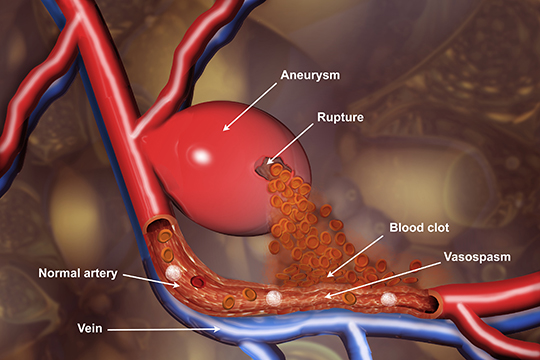On this page:
- •What is a subarachnoid hemorrhage?
- •What is an intracranial hemorrhage?
- •What are causes of a subarachnoid hemorrhage?
- •What are causes of an intracranial hemorrhage?
- •What are the symptoms of subarachnoid hemorrhages?
- •What are the symptoms of intracranial hemorrhage?
- •How are subarachnoid hemorrhages diagnosed?
- •How is an intracranial hemorrhage diagnosed?
- •Is surgery necessary for a subarachnoid hemorrhage?
- •Is surgery necessary for an intracranial hemorrhage?
- •What are non-surgical treatment options for a subarachnoid hemorrhage?
- •What are non-surgical treatment options for an intracranial hemorrhage?
- •What if the aneurysm hasn’t ruptured?
What is a subarachnoid hemorrhage?
A subarachnoid hemorrhage is bleeding in the space around the brain. This bleeding between the thin layers of tissue that cover the brain often causes serious consequences such as death or severe disability.
What is an intracranial hemorrhage?
Intracranial hemorrhage, also known as intracerebral hemorrhage, is a form of a stroke where there is bleeding on the brain.
We have 3 convenient locations throughout Southeastern Wisconsin.
What are the symptoms of subarachnoid hemorrhages?
The most common symptom of subarachnoid hemorrhage is severe headache. This is frequently associated with nausea, stiff neck, and sensitivity to light.
What are the symptoms of intracranial hemorrhage?
Symptoms of an intracranial hemorrhage vary, but usually develop without warning. This type of brain bleed can cause dizziness, sudden severe headache, nausea and vomiting, vision problems, muscle weakness in the limbs, changes in alertness or consciousness, seizures, difficulty breathing, and the inability to swallow or speak are some symptoms of intracranial hemorrhage.
If you are experiencing these symptoms or if you are at risk for a hemorrhage, call us today
How are subarachnoid hemorrhages diagnosed?
A computed tomography (CT or CAT) scan of the brain is used to diagnose the subarachnoid hemorrhage, and a cerebral angiogram is then performed to determine the size, location and status of the aneurysm.
During an angiogram, a thin flexible tube (catheter) is inserted into an artery in the upper thigh and guided through the blood system to the head.
Contrast dye is injected into the blood and then the blood flow to the brain can be observed under a specialized type of x-ray. The blood with the contrast will flow into the aneurysm, detailing the specific characteristics of the aneurysm. The size, shape and direction of the aneurysm, including associated blood vessels, can then be evaluated.
Dr. Ahuja and staff perform imaging procedures at The Brain and Spine Imaging Center, our state-of-the-art imaging facility in Franklin, Wisconsin.
How is an intracranial hemorrhage diagnosed?
When diagnosing an intracranial hemorrhage, a neurosurgeon may find decreases in brain function and swelling of the optic nerve upon physical examination of the patient. Various blood tests may be conducted to determine the cause and amount of bleeding. Computed tomography (CT or CAT), magnetic resonance imaging (MRI) or angiography (in which dye is injected into an artery and viewed with an x-ray) may be performed to diagnose the location and extent of the bleeding.
Dr. Ahuja and staff perform imaging procedures at The Brain and Spine Imaging Center, our state-of-the-art imaging facility in Franklin, Wisconsin.
Is surgery necessary for a subarachnoid hemorrhage?
Subarachnoid hemorrhage is a medical emergency. Patients should call 9-1-1 and go to the nearest emergency room immediately.
Patients with subarachnoid hemorrhage require treatment for the aneurysm as well as treatment for complications of the hemorrhage such as vasospasm (constricting of a blood vessel which reduces blood flow and increases pressure) and hydrocephalus (fluid build-up in the brain).
Craniotomy
The traditional surgical treatment for cerebral aneurysm is a craniotomy. A portion of the skull is removed to allow access to the brain and is then returned to position afterwards. The surgeon locates the aneurysm and a clip is applied to prevent further flow into the aneurysm. The patient will be in the intensive care unit after surgery and will remain in the hospital for at least a week.
Is surgery necessary for an intracranial hemorrhage?
An intracranial hemorrhage requires immediate care to reduce brain damage and prevent death. Treatment depends on the cause, location and extent of bleeding. Brain surgery may be necessary to repair blood vessels or remove areas where blood has collected (hematomas).
What are non-surgical treatment options for a subarachnoid hemorrhage?
Neuroendovascular therapy
In some cases the aneurysm that caused the subarachnoid hemorrhage is better treated with neuroendovascular therapy. Here microcatheters are placed in the arterial system and coils are delivered into the aneurysm. These coils fill the aneurysm, eliminating blood flow into the aneurysm. The surgeon, based on the type and location of the aneurysm, makes the determination as to whether the aneurysm should be coiled or clipped. Dr. Ahuja is one of the few neurosurgeons with extensive experience in both aneurysm clipping and aneurysm coiling.
What are non-surgical treatment options for an intracranial hemorrhage?
Sometimes less invasive neuroendovascular treatments can be used instead of open surgery. Medications may be prescribed to reduce swelling in the brain, reduce pain, and control seizures that can result from hemorrhaging. Intravenous infusion of medications, fluids and blood products may be necessary.
What if the aneurysm hasn’t ruptured?
In some cases, magnetic resonance imaging (MRI) or CAT scan may detect an aneurysm prior to any rupture. The treatment for unruptured aneurysms is much the same as for ruptured aneurysms. However, these patients are generally more stable and the surgical or endovascular procedure may be done electively rather than under emergency conditions.


